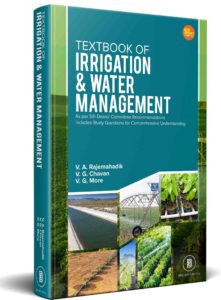Agriculture is the largest enterprise in India and it became the most significant entity on which economy of our country is mainly focused. Even though, our country is characterized as rainfed, in this context, after independence major efforts were taken for creation of irrigation resources by constructing dams, reservoirs etc. to accelerate the area under crop production. In this background government has taken serious efforts to boost up water resources in the country. Proper management and utilization of our water resources are the needs of the hour. The irrigation development projects have been constructed largely with a view to increase area under cultivation throughout the entire year. If the cropping intensity increases drastically, the sector will shift from a self-sustaining to an export oriented one. Era of natural resource management comes in existence for sustainability in agriculture production as water is the most important natural commodity and can’t be created artificially. This book helps to bridge the gap between the past experiences, present scenario and future roads by discussing the history of irrigation in India, water resources of the world and India, water movement in soil, the role in plants, soil moisture measurement, irrigation scheduling, methods of irrigation and various techniques in-relation to principles of irrigation are illustrated and summarized. The book will be very helpful for undergraduate degree programme throughout the country. With the current changes in the syllabus, the book is based on the latest Recommendations of the 5th Deans’ Committee.
1. Irrigation, Historical background of irrigation in India, Definition Irrigation and Water Management, its Objectives
2. Soil Water Relationship, Physical Properties of Soil, Volume Mass Relationship, Classification of Soil Water, Soil Moisture Constants, Water Available Forces Acting on Water Movement and Retension
3. Measurement of Moisture Content in Soil by Different Methods
4. Evaporation, Transpiration, Evapotranspiration, Factors Influencing ET.
5. Water Requirements, Irrigation Requirement, Method for Estimation of WR and Factors Affecting WR
6. Effective Rainfall, Definition, Methods of Estimation, Factors Affecting Effective Rainfall
7. Approaches of Irrigation Scheduling Frequency and Depth of Weeds Irrigation Measurement of Irrigation Water
8. Frequency and Depth of Irrigation
9. Study of Different Methods and Systems of Irrigation
10. Micro Irrigation and its Types, Drip Irrigation, Components and Merits and Demerits. Fertigation, Definition and Advantages
11. Irrigation Efficiencies, Concepts and Estimation
12. Water Quality Parameters, Management Strategies for Utilization of Poor Quality Water
13. Water Management of Cereals Oil Seeds, Pulses, Commercial Crops, Vegetable and Fruit Crops
14. Drainage, Causes of Water Logging, Effects of Bad Drainage, Types of Drainages, Effect of Drainage on Soil Improvement and Crop Growth
15. Drip irrigation System, its Operation, Maintenance, Mechanism of Fertigation
16. Sprinkler Irrigation System and its Components
17. Measurement of Discharge Rate, Emission Uniformity (EU) of Drip, Uniformity Coefficient of Sprinkler System and Wetted Diameter
18. Role of Nanotechnology in Irrigation Water Management
19. Precision Irrigation
20. Water Management for Problem Soils
21. Terminologies Used in Irrigation Water Management
22. Study Questions


